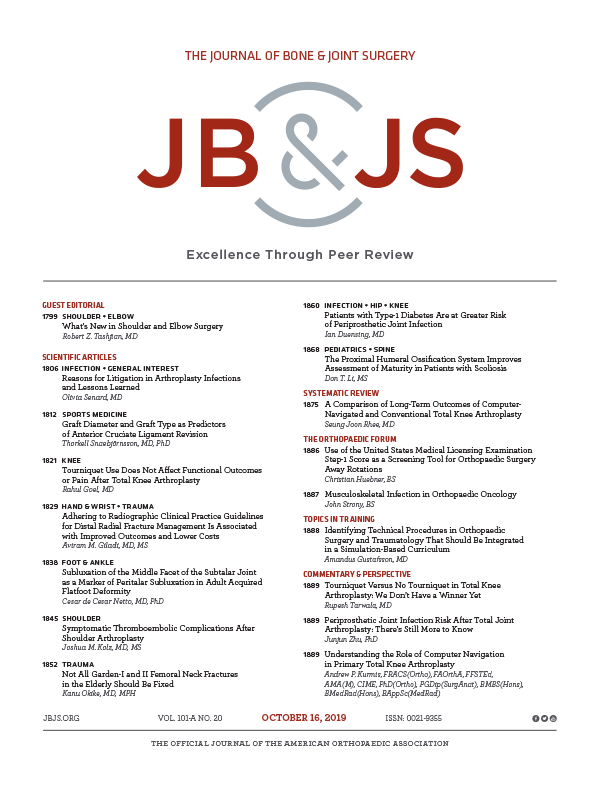
TKA: Intraoperative corticosteroid injections reduce hospital stay length

TKA: Intraoperative corticosteroid injections reduce hospital stay length
Effect of periarticular corticosteroid injections during total knee arthroplasty. A double-blind randomized trial
J Bone Joint Surg Am. 2009 Nov;91(11):2550-5.Did you know you're eligible to earn 0.5 CME credits for reading this report? Click Here
Synopsis
Seventy-six patients undergoing total knee arthroplasty were randomized to receive an intraoperative multi-modal periarticular injection with or without a corticosteroid. Patients who received the corticosteroid had significantly shorter hospital stays. No significant group differences in pain scores, narcotic consumption, outcome scores, or motion were identified up to 12 weeks post-surgery.
Was the allocation sequence adequately generated?
Was allocation adequately concealed?
Blinding Treatment Providers: Was knowledge of the allocated interventions adequately prevented?
Blinding Outcome Assessors: Was knowledge of the allocated interventions adequately prevented?
Blinding Patients: Was knowledge of the allocated interventions adequately prevented?
Was loss to follow-up (missing outcome data) infrequent?
Are reports of the study free of suggestion of selective outcome reporting?
Were outcomes objective, patient-important and assessed in a manner to limit bias (ie. duplicate assessors, Independent assessors)?
Was the sample size sufficiently large to assure a balance of prognosis and sufficiently large number of outcome events?
Was investigator expertise/experience with both treatment and control techniques likely the same (ie.were criteria for surgeon participation/expertise provided)?
Yes = 1
Uncertain = 0.5
Not Relevant = 0
No = 0
The Reporting Criteria Assessment evaluates the transparency with which authors report the methodological and trial characteristics of the trial within the publication. The assessment is divided into five categories which are presented below.
3/4
Randomization
4/4
Outcome Measurements
3/4
Inclusion / Exclusion
4/4
Therapy Description
4/4
Statistics
Detsky AS, Naylor CD, O'Rourke K, McGeer AJ, L'Abbé KA. J Clin Epidemiol. 1992;45:255-65
The Fragility Index is a tool that aids in the interpretation of significant findings, providing a measure of strength for a result. The Fragility Index represents the number of consecutive events that need to be added to a dichotomous outcome to make the finding no longer significant. A small number represents a weaker finding and a large number represents a stronger finding.
Why was this study needed now?
Adequate analgesia is an important aspect in the rehabilitation process following total knee arthroplasty. Intraoperative multi-modal analgesic injections have been demonstrated to decrease postoperative pain and improve early clinical outcomes. Corticosteroids are often a part of these multi-modal injections; however, currently no trials have specifically assessed the efficacy of corticosteroid inclusion in improving early postoperative outcomes.
What was the principal research question?
Does an intraoperative periarticular corticosteroid injection reduce pain and improve functional outcomes of patients undergoing total knee arthroplasty compared to those undergoing a similar injection without the steroid?
What were the important findings?
- There were no differences in mean narcotic consumption, pain scores on the first post operative day, or pain scores on the day of discharge (p>0.05)
- The corticosteroid group had a significantly shorter mean hospital stay of 2.6 +/- 0.7 days compared to 3.5 +/- 1.9 days for patients in the no-steroid group (p=0.01)
- Both groups demonstrated significant improvements in knee range of motion and Knee Society knee and function scores from preoperative measures (p<0.05); however, there were no differences between the two treatment groups
- No complications were noted in the no-steroid group and 3 (including 1 infection) were observed in the steroid group; this difference was not significant (p=0.24)
What should I remember most?
The addition of a corticosteroid to an intraoperative periarticular multi-modal injection did not improve pain relief, motion, or function in the early postoperative period. However, the steroid injection reduced the hospital stay of patients undergoing total knee arthroplasty compared to the control.
How will this affect the care of my patients?
The use of a corticosteroid as an adjunct to multi-modal intraoperative injections may result in shorter hospital stays, but will have no effect on postoperative pain, range of motion, or function. Further research is needed to confirm these results and determine if there are differences in complications attributed to the addition of corticosteroid.
Learn about our AI Driven
High Impact Search Feature
Our AI driven High Impact metric calculates the impact an article will have by considering both the publishing journal and the content of the article itself. Built using the latest advances in natural language processing, OE High Impact predicts an article’s future number of citations better than impact factor alone.
Continue



 LOGIN
LOGIN

Join the Conversation
Please Login or Join to leave comments.